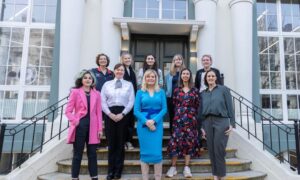This week, in my quest to better understand the community of Brighton Girls, I have been making a conscious effort to shift my perspective. On Monday, I joined Brian, one of our bus drivers, on his morning run. This fully immersive experience did wonders for my knowledge of the local topography and added to my list of desirable-days-out in the Sussex countryside. In another attempt to see things differently, I set up a ‘pop-up’ office in the library. From my usual vantage point, I have a splendid view of the Temple Building, the school entrance and car park. By relocating my office to the heart of the school, I have enjoyed a completely different outlook.
However, it is not all about the view. What I really set out to do this week was to develop empathy. Empathy – the capacity to understand or share the feelings of others – is essential to any community. Empathy is at the heart of our personal wellbeing; it is an attribute that appears with increasing frequency on employers’ lists of desirable dispositions; it is a word that is appearing around school as the first stage of the Design Thinking process, the principles of which we are working to embed in our teaching and learning. Empathy is one of the most powerful tools we have: without it, it is impossible to identify the right problems, and impossible to find the right solutions; with it, a community will thrive.
But it struck me that much of the language we use when talking about empathy and understanding is shaped by the visual. We talk about “seeing the world through someone else’s eyes”; when we deepen our understanding we develop “insight”; when we refer to someone’s opinion, we use the word ‘viewpoint’. Do you get the picture? Even the oft-quoted line about empathy, from the great Atticus Finch in ‘To Kill a Mockingbird’, is expressed in visual terms: “You never really understand a person until you consider things from his point of view… until you climb into his skin and walk around in it”. All these forget that we can’t actually step into someone else’s shoes, or see through other eyes; it is impossible to shift our perspective in the true sense of the word (from the Latin ‘specere’ meaning ‘to look’). This thought struck me acutely during Monday’s assembly as I listened to Holocaust Survivor, Ceska Abrahams, telling her story to mark Holocaust Memorial Day. Ceska’s story – one of incredible fortitude in the face of unthinkable pain and privation – both moved and inspired us, but none of us could say that we fully understood. How could we?
So, what can we do if we want to develop empathy?
We can listen.
As we did on Monday morning, when the whole school stopped for an hour to listen to Ceska, we can stop, we can listen and can make time to hear people’s stories.
So, my ‘pop-up’ office may have given me a new a room with a new view, but it was the spontaneous conversations I had with pupils and staff that were most valuable. Likewise, watching the sun come up over the Downs (albeit through a rain-splashed minibus window) was great on Monday, but more important was the understanding I gained of the daily routines of the girls and of our bus drivers – by making the time to talk and listen, I now have a deeper appreciation of their Brighton Girls experience, something that will be important when making decisions in the future.
My response to all the people I spoke to this week, therefore, is not, “I see what you mean” but rather, “I hear you”.


